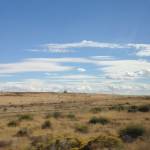Multicellular Life
.75-3.0 billion BCE • Earth
"Billions of years ago, life crossed a threshold. Single cells started to band together, and a world of formless, unicellular life was on course to evolve into the riot of shapes and functions of multicellular life today, from ants to pear trees to people...
Hints of multicellularity date back 3 billion years, when impressions of what seem to be mats of microbes appear in the fossil record. Some have argued that 2-billion-year-old, coil-shaped fossils of what may be blue-green or green algae—found in the United States and Asia and dubbed Grypania spiralis—or 2.5-billion-year-old microscopic filaments recorded in South Africa represent the first true evidence of multicellular life...
Plants and animals each made the leap to multicellularity just once. But in other groups, the transition took place again and again. Fungi likely evolved complex multicellularity in the form of fruiting bodies... on about a dozen separate occasions... The same goes for algae: Red, brown, and green algae all evolved their own multicellular forms over the past billion years or so...
Once organisms had crossed the threshold to multicellularity, they rarely turned back. In many lineages, the number of types of cells and organs continued to grow, and they developed ever-more-sophisticated ways to coordinate their activities... Touched off by the initial transition from one cell to many, a cycle of increasing complexity took hold, and the richness of multicellular life today is the result."
Source: "The momentous transition to multicellular life may not have been so hard after all" Elizabeth Pennisi. Science Magazine. Jun. 28, 2018.
Image Source: Asci and ascospores, Morchella elata (morel). Peter G. Werner, Merritt College, Oakland, CA. 13 May 2008. CC by 3.0


Learn about Maya Lin’s fifth and final memorial: a multi-platform science based artwork that presents an ecological history of our world - past, present, and future.

Discover ecological histories and stories of former abundance, loss, and recovery on the map of memory.

Learn how we can reduce our emissions and protect and restore species and habitats – around the world.

See how art can help us rethink the problems we face, and give us hope that each one of us can make a difference.

Help make a global memorial something personal and close to home. Share your stories of the natural world.


